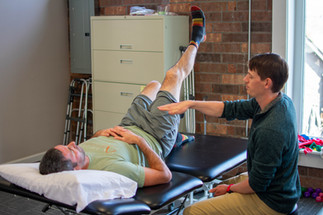Return to Running: The Initial Evaluation
- Ben Stephenson

- May 8
- 3 min read
One of our physical therapists, Ryan Marquart, agreed to be the subject of our case study series for the next few weeks. The aim of this series is to give an example of a typical plan of care with physical therapy. Ryan’s ultimate goal is to run a race later this summer.

At Ryan’s first appointment we wanted to get a full assessment by performing both a running gait analysis and physical examination. We began our session by gathering a thorough subjective history of Ryan’s current condition. He has a history of left knee pain from a previous snowboarding crash in 2013 that has limited his ability to participate in running consistently. Ryan also more recently had a mountain biking crash 3 weeks prior causing some generalized soreness, bruising, and some abrasions in the L shoulder, L hip, and L knee. He did not have any fractures from the crash and has steadily been improving his mobility since the event.
During Ryan’s gait analysis, we took a video at a variety of angles to be able to perform a full analysis of his running form. Most of the impairments identified occurred during the stance phase on his left lower extremity. The following findings were identified:
He demonstrated an early heel rise on the left compared to the right. This can suggest talocrural restriction (or ankle joint restriction) or can be due to a lack of flexibility in the muscles of the calf.
His knee alignment during the stance phase on the left lower extremity he demonstrated right hip drop. This often indicates weakness in the hip abductors.
During the stance phase on the left lower extremity he also had a compensatory left trunk shift.
To further investigate causes of Ryan’s impairments we performed a series of tests, but the following findings were identified:
Restriction in soleus flexibility with half kneeling soleus flexibility test (less than <40deg angle identified) contributing to early heel rise.
Significantly more ankle instability, knee valgus (knee diving inward) and hip drop when performed on the left lower extremity demonstrating impairments in dynamic stabilization with left lower extremity.
Positive thomas test indicating a lack of flexibility in the quadriceps and iliopsoas.
Weakness in the hip abductors and external rotators, more significant on the left lower extremity than the right lower extremity.
Moderate tenderness upon palpation of the patellar tendon and some trigger points identified in the quadriceps associated with his chronic patellar tendinopathy.
Given the above impairments and gait abnormalities identified, we worked together to establish his initial home exercise program.
Single leg bridge and side stepping with a band to emphasize isolated strengthening of a weaker muscle group important for hip control during the stance phase of gait with running.
6 inch lateral step down with a mirror for visual feedback to work on training for knee control with a more dynamic, functional task.
Single leg balance on a bosu surface for proprioceptive training for the ankle, knee, hip.
Half kneeling soleus stretch and Thomas stretch to work on flexibility for both the soleus, hip flexors and quadriceps.
To wrap up Ryan’s initial session, we also perform some dry needling for Ryan’s quadriceps and patellar tendon. The goal of the needling was to address soft tissue restriction/trigger points noted in the quads and to stimulate the inflammatory cascade/healing response for his patellar tendon. Ryan tolerated all interventions above well and noted immediate relief in his medial knee after the needling today. I recommended Ryan perform his exercise program at least 4-5x/week. Continue to follow along with us as we track Ryan’s progress as he works toward participating in a race later in the summer!
Ben Stephenson
PT, DPT


























